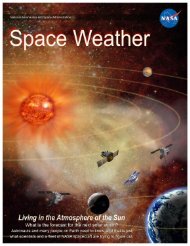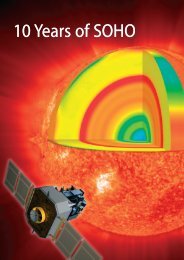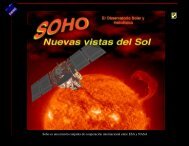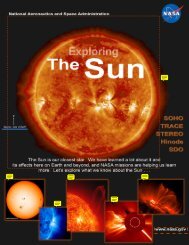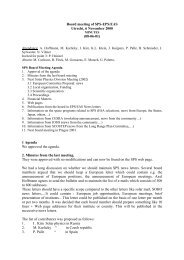Four years of SOHO Discoveries-Some Highlights - Nasa
Four years of SOHO Discoveries-Some Highlights - Nasa
Four years of SOHO Discoveries-Some Highlights - Nasa
- No tags were found...
You also want an ePaper? Increase the reach of your titles
YUMPU automatically turns print PDFs into web optimized ePapers that Google loves.
soho discoverieswhich connect the sunspot with surroundingpores <strong>of</strong> the same polarity. Pores with theopposite polarity are not connected to the spot.MDI has also made the first observations <strong>of</strong>seismic waves from a solar flare, opening uppossibilities for studying both the flares and thesolar interior. During the impulsive phase <strong>of</strong> theX2.6-class flare <strong>of</strong> 9 July 1996, a high-energyelectron beam caused an explosive evaporation<strong>of</strong> chromospheric plasma at supersonicvelocities. The upward motion was balanced bya downward recoil in the lower chromosphere,which excited propagating waves in the solarinterior. On the surface, the outgoing circularflare waves resembled ripples from a pebblethrown into a pond (Fig. 9). The seismic wavepropagated at least 120 000 km from the flare’sepicentre, with an average speed <strong>of</strong> about50 km/s on the solar surface.Transition-region dynamicsExplosive events and ‘blinkers’Several types <strong>of</strong> transient events have beendetected in the quiet Sun. High-velocity eventsin the solar transition region, also called‘explosive events’, were first discovered in theearly eighties based on ultraviolet observationswith the High-Resolution Telescope-Spectrometer(HRTS) rocket payload. They have largevelocity dispersions, approximately ±100 km/s,i.e. velocities are directed both towards andaway from the observer causing a strongbroadening <strong>of</strong> the spectral lines observed.Explosive events have been studied extensivelyby a number <strong>of</strong> authors using SUMER data,and several results support the magneticreconnection origin <strong>of</strong> these features. Innes etal. have reported explosive events that showspatially separated blue- and red-shifted jetsand some that show transverse motion <strong>of</strong> blueand red shifts, as predicted if reconnectionwas the source (Fig. 10). Comparisons withmagnetograms from MDI and those obtainedat ground-based solar observatories have alsoprovided evidence that transition-region explosiveevents are a manifestation <strong>of</strong> magneticreconnection occurring in the quiet Sun.Harrison et al. have presented a comprehensivestudy <strong>of</strong> EUV flashes, also known as ‘blinkers’,Figure 8. The subsurface sound speedperturbations in a sunspot region observed on20 June 1998 by MDI. The horizontal size <strong>of</strong>the box is 13 deg (158 Mm), the depth is24 Mm. The horizontal cut in panels (a) and (b)reaches down to a depth <strong>of</strong> 21.6 Mm, while inpanel (c) it is 4.8 Mm deep. Positive variationsare shown in red, negative variations in blue.Scaling: ±1 km/s (from Kosovichev et al.)75



